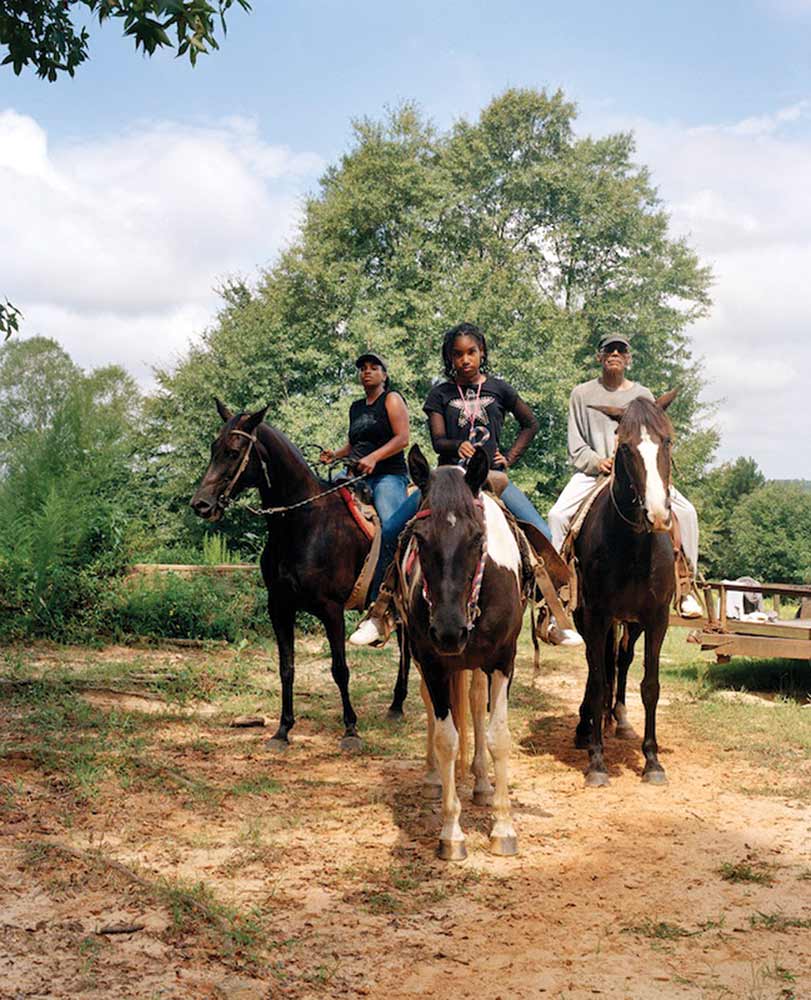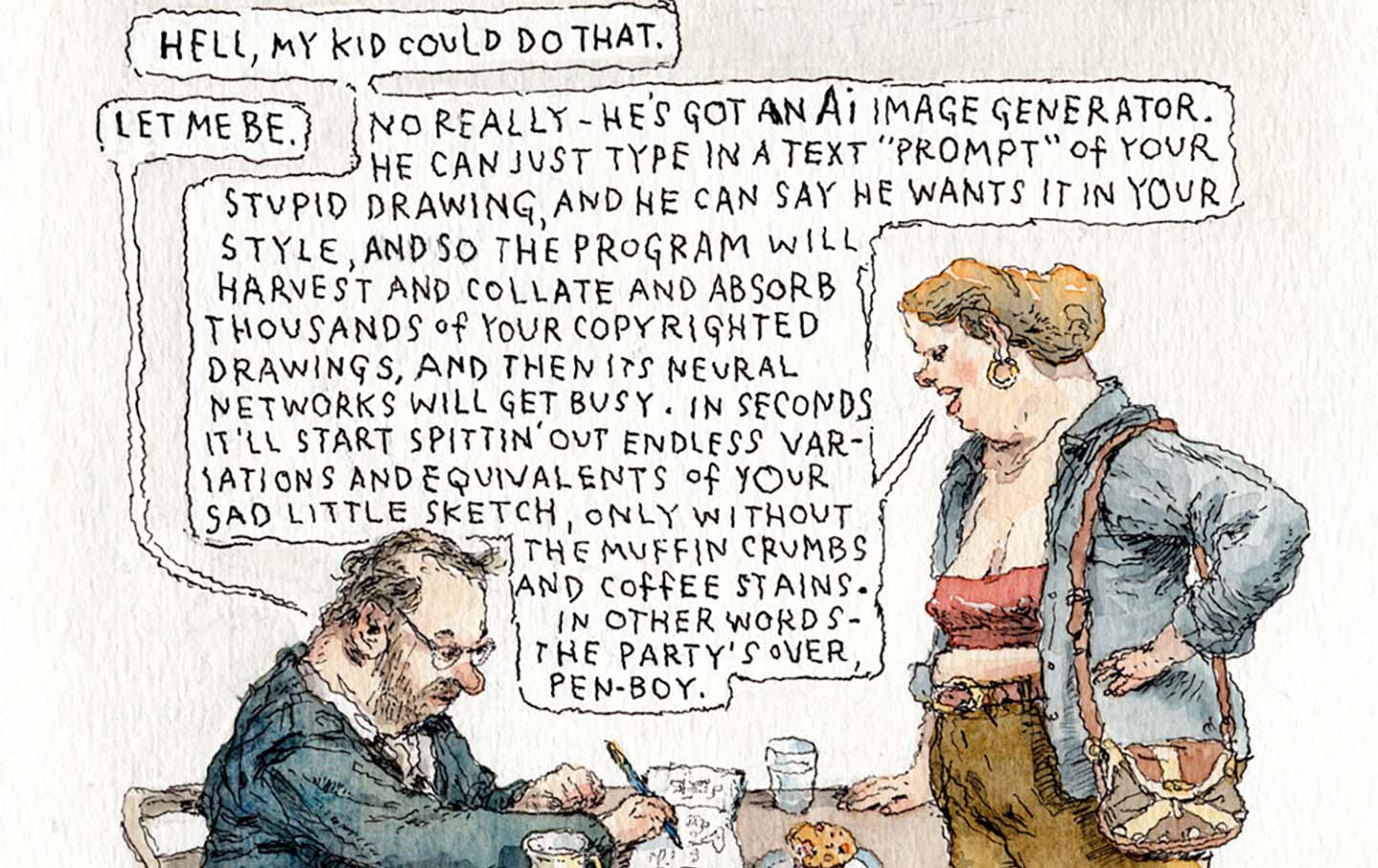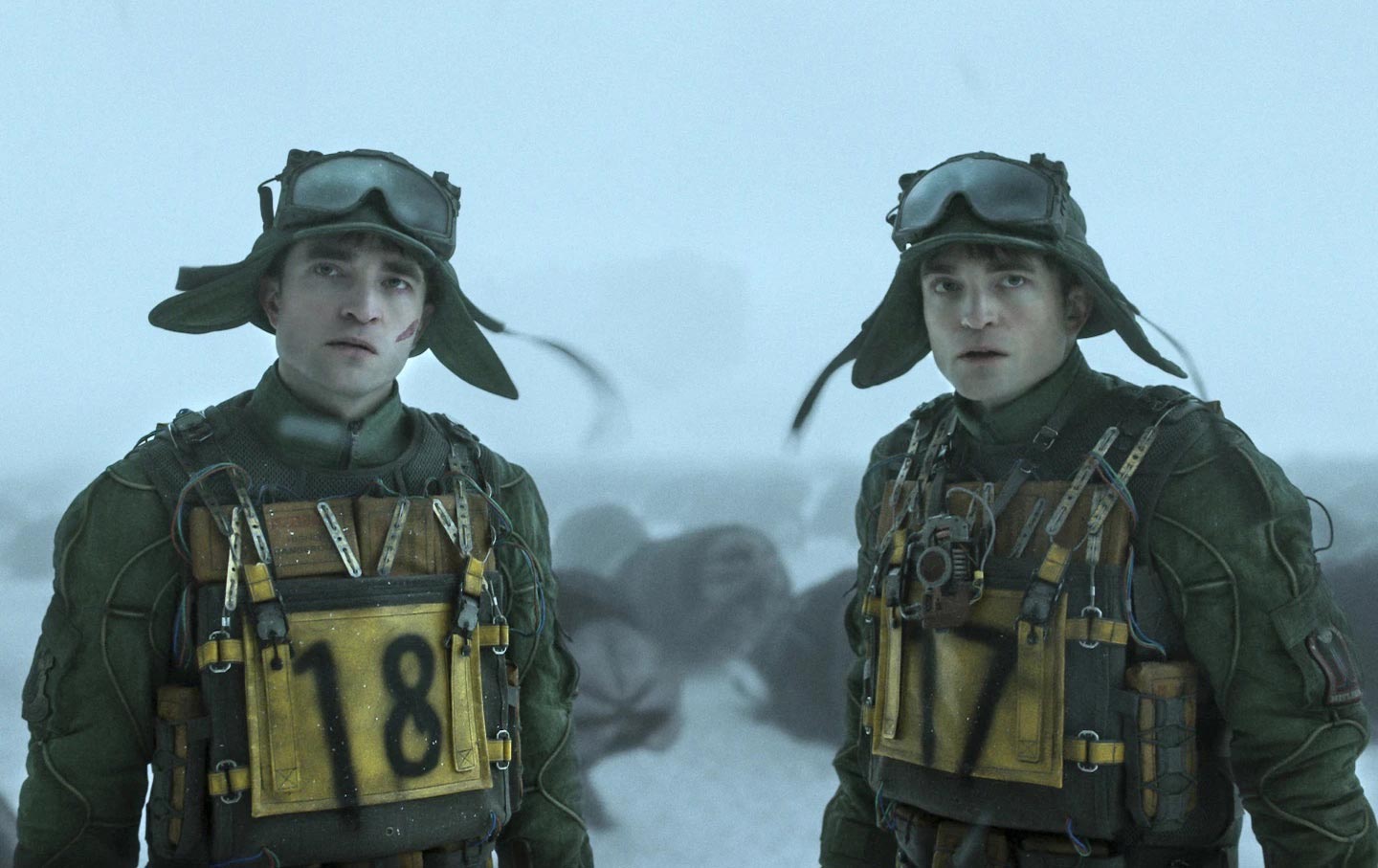How We See
LaToya Ruby Frazier and the new rules of documentary photography
LaToya Ruby Frazier Rewrites the Rules of Documentary Photography
A new career survey at the MoMA is a perfect illustration of the photographer’s mission: to reframe how viewers see the working-class and low-income people whom she counts as kin.

There are many stunning images in LaToya Ruby Frazier’s breakout first series, The Notion of Family (2001–14), but one in particular captures the essence of her work. Landscape of the Body (Epilepsy Test) is a diptych that pairs two black-and-white photos: On the left, a Black woman sits on a bed with her back to us, much of it exposed between the open sides of a medical gown; the wires attached to her head descend and then rise up, plugged into an EEG machine. On the right, we see a section of a building that has been partially demolished; wires, along with pieces of concrete and metal, form the structure’s jagged, cascading husk.
The woman is Frazier’s mother, who suffers from seizures, and the building is—or was—the University of Pittsburgh Medical Center (UPMC) Braddock Hospital, which closed in 2010 and was demolished shortly thereafter. It was the only hospital in Frazier’s hometown of Braddock, Pennsylvania, which lies just upriver from Pittsburgh. Braddock is a steel town: Between 1873 and 1875, Andrew Carnegie built a mill there that still operates today, despite the collapse of the industry and white flight.
Frazier’s diptych is deeply personal: It parallels her family’s health struggles with the ongoing destruction of her hometown and, with it, a vital institution of care. It’s also symbolic of the broader human costs of unfettered capitalism: UPMC is a behemoth, with billions in both real estate holdings and revenue; it claims to be Pennsylvania’s largest employer after the state government. According to a 2018 report in Jacobin, the company—which is technically a nonprofit—has a pattern of closing hospitals in low-income communities, so that “in one fell swoop, UPMC snatched away both Braddock’s biggest employer and its only dedicated emergency room.”
Landscape of the Body (Epilepsy Test) is among the works included in a new survey of Frazier’s career, “Monuments of Solidarity,” at the Museum of Modern Art in New York City. The exhibition features photographs, videos, and interviews that chronicle an unfolding, multipronged emergency facing communities throughout the United States, from Braddock to Baltimore to Flint, Michigan. Frazier documents the forces of deindustrialization, racism, illness, and pollution playing out in people’s lives—as well as their strength and resilience in confronting them.
It’s perhaps not enough to say, though, that Frazier simply “documents” these communities; as “Monuments of Solidarity” demonstrates, she embeds herself within them in order to capture some of their complexity. Building on the work of predecessors like Gordon Parks and Dawoud Bey, Frazier has made it her mission to further revise the rules of social-documentary photography, which traditionally mandate keeping a measure of distance from one’s subjects. The results are stirring: a full-throated effort to reframe how viewers see the working-class and low-income people whom she counts as kin. At the same time, it’s an uneasy fit for MoMA, which is about as corporate and exclusionary as museums come. Can an avowedly elite art institution facilitate an honest conversation about class and race? This question isn’t particular to Frazier’s exhibition, but the show inadvertently highlights how pertinent and pressing it has become.
Frazier grew up in the poorest neighborhood in Braddock under the care of her grandmother. She drew and painted as a child, began taking pictures in high school, and then went to college at Edinboro University in Western Pennsylvania, where she studied photography with the artist Kathe Kowalski. Her education at Edinboro was grounded in politics from the start: She learned about Dorothea Lange and the history of social-documentary photography, as well as James Baldwin’s essays and Carrie Mae Weems’s conceptual art, which challenges racial and class stereotypes, particularly regarding the Black family.
By the time she was 19, Frazier had embarked on the project that would become The Notion of Family: a series of black-and-white photographs, plus a few color videos, depicting herself, her mother, and her grandmother in their homes, with glimpses of crumbling Braddock around them. The work was collaborative, especially the photos with her mother; many of the pictures feature the two standing side by side or one in front of the other, so that their figures merge. What makes the series so remarkable is its central tension: Frazier is an insider chronicling the conditions of her family’s life—poverty and illness, love and care—but her role as a documentarian adds the critical perspective of a dispassionate outsider. The photographs present tender intimacy alongside unsparing honesty; there is no romance or melodrama, just a weary, guarded defiance.
The Notion of Family, which took 13 years to complete, brought Frazier critical attention and acclaim. She began exhibiting in galleries and was included in important group shows like the New Museum’s “Younger Than Jesus” triennial and the Whitney Biennial. In 2014, she received a Guggenheim Fellowship, and Notion was published as a book. The following year, she won a MacArthur Fellowship at age 33.
For her next big project, Frazier turned to the Flint water crisis, which had begun when, in a bid to save money, a state-appointed manager changed the source of the city’s drinking water from a public system in Detroit to the highly polluted Flint River. Frazier’s series, Flint Is Family in Three Acts (2016–20), began as a photo essay for Elle magazine but soon expanded into something much larger. As with Notion, the project’s backbone was the story of a multigenerational family of women: in this case, a poet named Shea Cobb; her daughter, Zion; her mother, Ms. Renée; and her best friend, Amber Hasan, a writer. Rather than focus solely on the devastation wrought by the crisis, as many news photographers had already done, Frazier sought to capture the fullness of the Cobb family’s daily existence, with the water problem sometimes front and center and other times hovering in the background. In one photo, for instance, Zion looks up from her math homework, which is spread out on a bed, and offers a slight smile, while a bottle and a jug of clean drinking water loom on a table at the right edge of the frame.
Frazier lived in Flint for five months but still didn’t feel that her work was complete. When Shea and Zion moved to Mississippi temporarily to live with Shea’s father, Frazier followed and photographed them there; one picture shows them bending down and cupping fresh water from a spring in their hands, as if they were panning for gold. The third act of the series follows the installation of an atmospheric water generator—which extracts moisture from the air and turns it into drinkable water—back in Flint, thanks to its creator, an Army veteran named Moses West; the efforts of Hasan; and funds raised by Frazier herself, who by that time had been working on the project for three years. Unlike the rest of the series, these photographs are in color and mostly show members of the community standing for portraits with the machine.
At MoMA, these images are displayed on steel stands with panels of text alongside them: testimonies by the subjects about their experiences of the crisis. Standing before and between the panels in the gallery creates a surprising feeling of closeness to both the people depicted and the work itself—something you don’t often get at MoMA, a tourist-filled space where the behavior of visitors, including the distance they keep from the art on the walls, is highly policed. The installation also forces you into a greater awareness of and possible communion with the other viewers around you, as you maneuver between the panels and linger over the words.
Frazier went on to use similar formats for two more projects, both of which are included at MoMA: The Last Cruze (2019) and More Than Conquerors: A Monument for Community Health Workers of Baltimore, Maryland (2021–22). The latter spotlights the efforts of community health workers, many of whom are Black women, acting as liaisons between patients, the healthcare system, and social services in Baltimore. Their portraits and testimonies are displayed on panels attached to the poles used for IV bags, which stand six feet apart—the recommended space for social distancing during the Covid-19 pandemic.
The Last Cruze, meanwhile, is focused on a General Motors factory in Lordstown, Ohio, that made the Chevrolet Cruz. In late 2018, GM announced that it would move the Cruz’s manufacturing abroad and “unallocate” the plant (an ambiguous term that the company used for legal reasons and essentially meant halting production). Frazier visited Lordstown in the following months, and although she was barred from entering the factory, she gained the trust of the plant’s union to photograph and interview workers and their families. The resulting black-and-white pictures are interspersed with texts in which the subjects detail their relationships to the plant and the effects of its shutdown. The panels hang on a red aluminum armature that runs the length of the gallery, with 21 consecutive pieces that evoke the assembly line, the nave of a church, and a spine.
When Frazier began studying photography back in college, she was inspired by its history as a tool for social change yet also concerned by the inequalities that its practitioners, despite their good intentions, often reproduced. “When I see Dorothea Lange’s 1936 photograph Migrant Mother, I see a structure of power: government first, corporation second, commissioned photographer third, subject/sitter fourth,” Frazier writes in the catalog for the MoMA exhibition. “I’ve sought to invert this power dynamic in order to create a paradigm shift.”
In 1936, Lange was working for a federal agency, documenting the Great Depression. She took a picture of an impoverished woman framed by her three children that quickly became iconic. But no one—Lange included—knew who the woman was until more than 40 years later, when a reporter found her in central California. Thanks to Lange’s photo, Florence Owens Thompson had become the face of the Great Depression, but that hadn’t done anything to improve her life.
Popular
“swipe left below to view more authors”Swipe →Frazier’s entire practice has been an activist attempt to rectify this power imbalance—to make the subjects of her photography more than stereotypes or nameless faces. In addition to the text excerpts from interviews that she includes, she also invites her subjects to speak in video and audio recordings, of which there are several at MoMA. The success of these formats is mixed: The texts are fascinating but seem better suited to a book; the recordings are sometimes compelling and other times in need of editing. (The installations, it’s worth noting, feel cramped in the relatively small galleries that MoMA has allotted to them.) But there’s no question that the testimonies are essential to Frazier’s work and to understanding the portrait of America that she’s capturing: a country where being disenfranchised—by the government, by racism, by capitalism, by environmental neglect—also means being denied an official forum in which to speak your truth.
And yet, what struck me as I walked through the exhibition was Frazier’s ability to give voice to her subjects through the medium of photography itself. Working against the myth of the singular artist, she builds a conversation with images by including other people’s photographs in her work. In her most recent project, a tribute to Dolores Huerta, Frazier shot the 94-year-old labor leader standing with a print of Migrant Mother at the camp where Lange took her original photo. For The Last Cruze, Frazier made a video of autoworker Kasey King’s pictures of the final car coming off the assembly line; she also used archival material, as in a magnificent image of one of the workers, Christina Defelice, standing with an old photo of her father—who also worked at the plant—projected onto her (Defelice looks like a powerful ghost).
Family photos recur in both the Flint series and The Notion of Family, which recalls, for me, bell hooks’s writing (another touchstone for Frazier) on the importance of the snapshot in Black communities: “More than any other image-making tool, the camera offered African-Americans, disempowered in white culture, a way to empower ourselves through representation,” hooks notes. “For black folks, the camera provided a means to document a reality that could, if necessary, be packed, stored, moved from place to place. It was documentation that could be shared, passed around.”
Clearly, by incorporating other people’s pictures, Frazier is emphasizing the value of collaboration and collectivity. She’s asserting the importance of the past in understanding who we are today—a vital message in a country forever caught in the throes of historical amnesia. She’s also working from the ground up to construct an alternate history of her own: a lineage of documentary photography that honors the power and truth of Migrant Mother while also asking about the stories that such an image could never tell.
When you exit the galleries containing most of Frazier’s show at MoMA, you land in a hallway where one more project is installed—Pier 54: A Human Right to Passage (2014), a series of photographs of Frazier on a dilapidated pier in Manhattan brandishing flags printed with archival images that reference the policing of borders in New York Harbor. Streaming over a set of speakers in the space is an ethereal version of the labor anthem “Solidarity Forever,” written by Ralph Chaplin in 1915 and here played by Frazier on guitar. While I stood there listening, I watched visitors snap selfies and pose for portraits with the blown-up images behind them, possibly unaware of the message the piece was blaring.
On the one hand, it’s fitting to hear this song in this space: There’s a long history of labor organizing at MoMA, including the founding of the Professional and Administrative Staff Association of the Museum of Modern Art (which goes by the terrific acronym PASTA) in 1971; that same year, The New York Times identified PASTA as “the first self-organized union of professional employees—as opposed to maintenance and service people—at a privately financed museum,” calling it “nothing short of historic.” Maintenance and service workers at MoMA, as well as security guards, are represented by different unions—in fact, some of those workers at MoMA PS1, the museum’s affiliate institution in Queens, were rallying as recently as this past February to demand better wages and health benefits amid drawn-out contract negotiations. Such actions aren’t new: The history of organizing at MoMA includes countless examples of workers and artists protesting and striking to fight back against discriminatory policies, cost-cutting measures, and war-profiteering board members.
On the other hand, the average museum visitor likely doesn’t know any of this. That visitor also won’t necessarily know that MoMA is a nonprofit turned corporate giant, with more than $2 billion in assets and millions in revenue. MoMA’s director, Glenn Lowry, makes $2 million a year and lives in a rent-free luxury apartment above the museum, while the minimum yearly salaries of cashiers and salespeople range from $40,000 to $45,000. What the average MoMA visitor does know is that a single adult ticket costs $30—a significant amount of money to pay to look at art.
Of course, MoMA isn’t unique. Many museums, both big and small, have similar problems or are hypocritical in a host of other ways. Frazier isn’t at fault for operating within the art world, which—happily—values her work. But with a show like this one, in particular, it’s hard not to feel the sharp edges of this paradox. (Nor am I the first critic to point it out.) Frazier’s work reflects such a clear commitment to exposing the problems that MoMA itself, as an institution, entrenches. This disjuncture doesn’t dilute the exhibition so much as place it in relief: Alongside the power of art, there’s the simultaneous reality of its limitations. A show about solidarity in a place built on inequality is vital, instructive, and necessarily constrained.
It may well be that those who can afford to go to MoMA are the ones most in need of Frazier’s wake-up call. But we all deserve better than a system that treats art like an asset and siloes it away in inaccessible institutions. Because this is, in the end, one of the lessons of Frazier’s art: There’s creativity to be found everywhere, if only you’re willing to look.








